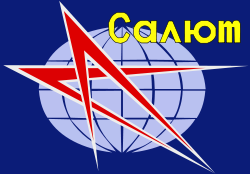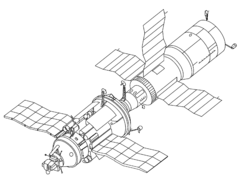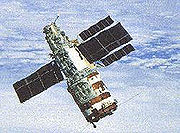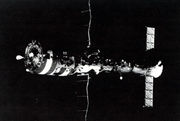Salyut 7
 |
||
| Salyut 7 photographed following the undocking of Soyuz T-13, September 25, 1985 | ||
 |
||
| Station statistics | ||
|---|---|---|
| Crew | 3 | |
| Launch | April 19, 1982 19:45:00 UTC |
|
| Launch pad | LC-200/40, Baikonur Cosmodrome, USSR | |
| Reentry | February 7, 1991 | |
| Mass | 19,824 kg | |
| Length | ~16 m | |
| Width | 4.15 m | |
| Pressurised volume | 90 m³ | |
| Perigee | 219 km (118.25 nmi) | |
| Apogee | 278 km (150.1 nmi) | |
| Orbital inclination | 51.6 degrees | |
| Orbital period | 89.2 minutes | |
| Days in orbit | 3216 days | |
| Days occupied | 816 days | |
| Number of orbits | 51,917 | |
| Distance travelled | 2,106,297,129 km (1,137,309,460 nmi) |
|
| Statistics as of de-orbit and reentry | ||
| Configuration | ||
 |
||
| Salyut 7 with docked Cosmos 1686 TKS spacecraft | ||
Salyut 7 (Russian: Салют-7; English: Salute 7) was the final space station launched into Low Earth orbit as part of the Soviet Union's Salyut Program. Launched on April 19, 1982, on a Proton rocket from Site 200/40 at the Baikonur Cosmodrome in the USSR, Salyut 7 was part of the transition from "monolithic" to "modular" space stations, acting as a testbed for docking of additional modules and expanded station operations. It was also the tenth space station of any kind launched.
Contents |
Description

Salyut 7 was the back-up vehicle for Salyut 6 and very similar in equipment and capabilities. With delays to the Mir programme it was decided to launch the back-up vehicle as Salyut 7. In orbit the station suffered a number of technical failures though it benefited from the improved payload capacity of the visiting Progress and Soyuz craft and the experience of its crews who improvised many solutions (such as a fuel line rupture in September 1983 requiring EVAs by the Soyuz T-10 to repair). It was aloft for eight years and two months (a record not broken until Mir), during which time it was visited by 10 crews constituting 6 main expeditions and 4 secondary flights (including French and Indian cosmonauts). Also saw two flights of Svetlana Savitskaya making her the second woman in space since 1963 and the first to perform an EVA. Aside from the many experiments and observations made on Salyut 7, the station also tested the docking and use of large modules with an orbiting space station. The modules were called "Heavy Cosmos modules" though in reality were variants of the TKS spacecraft intended for the cancelled Almaz military space station. They helped engineers develop technology necessary to build Mir. Salyut 7 deorbited on February 7, 1991.
It had two docking ports, one on either end of the station, to allow docking with the Progress unmanned resupply craft, and a wider front docking port to allow safer docking with a Heavy Cosmos module. It carried three solar panels, two in lateral and one in dorsal longitudinal positions, but they now had the ability to mount secondary panels on their sides. Internally, the Salyut 7 carried electric stoves, a refrigerator, constant hot water and redesigned seats at the command console (more like bicycle seats). Two portholes were designed to allow ultraviolet light in, to help kill infections. Further, the medical, biological and exercise sections were improved, to allow long stays in the station. The BST-1M telescope used in Salyut 6 was replaced by an X-ray detection system.
Crews and missions

Following up the use of Cosmos 1267 on Salyut 6, the Soviets launched Cosmos 1443 on March 2, 1983, from a Proton SL-13. It docked with the station on March 10, and was used by the crew of Soyuz T-9. It jettisoned its recovery module on August 23, and re-entered the atmosphere on September 19. Cosmos 1686 was launched on September 27, 1985, docking with the station on October 2. It did not carry a recovery vehicle, and remained connected to the station for use by the crew of Soyuz T-14. Ten Soyuz T crews operated in Salyut 7. Only two InterCosmos "guest cosmonauts" worked in Salyut 7. The first attempt to launch Soyuz T-10 was aborted on the launch pad when a fire broke out at the base of the vehicle. The payload was ejected, and the crew was recovered safely.
Salyut 7 had six resident crews.
- The first crew, Anatoli Berezovoy and Valentin Lebedev, arrived on May 13, 1982 on Soyuz T-5 and remained for 211 days until December 10, 1982.
- On June 27, 1983 the crew of Vladimir Lyakhov and Alexander Alexandrov arrived on Soyuz T-9 and remained for 150 days, until November 23, 1983.
- On February 8, 1984 Leonid Kizim, Vladimir Solovyev, and Oleg Atkov began a 237 day stay, the longest on Salyut 7, which ended on October 2, 1984.
- Vladimir Dzhanibekov and Viktor Savinykh (Soyuz T-13) arrived at the space station on June 6, 1985.
- On September 17, 1985 Soyuz T-14 docked with the station carrying Vladimir Vasyutin, Alexander Volkov, and Georgi Grechko. Eight days later Dzhanibekov and Grechko left the station and returned to Earth after 103 days, while Savinyikh, Vasyutin, and Volkov remained on Salyut 7 and returned to Earth on November 21, 1985 after 65 days.
- On May 6, 1986 Soyuz T-15 carrying Leonid Kizim and Vladimir Solovyov docked with the space station. The Soyuz had come from the Mir space station and returned to Mir after 50 days on Salyut.
There were also four visiting missions, crews which came to bring supplies and make shorter duration visits with the resident crews.
Technical problems
The station suffered from two major problems, the first of which required extensive repair work to be performed on a number of EVAs. On September 9, 1983, during the stay of Vladimir Lyakhov and Alexander Alexandrov, while reorienting the station to perform a radiowave transmission experiment, Lyakhov noticed the pressure of one fuel tank was almost zero. Following this, Alexandrov spotted a fuel leak looking through the aft porthole. Ground control decided to try to repair the damaged pipes, in what was to be the most complex repair attempted during EVA at the time. However this was to be attempted by the next crew, the current one lacking the necessary training and tools. The damage was eventually repaired by Leonid Kizim and Vladimir Solovyov, who after four EVA managed to fix two leaks but needed a special tool to fix the third. The tool was delivered by Soyuz T-12, and the leak was subsequently fixed.[1]
On February 12, 1985, contact with Salyut 7 was lost. The station began to drift, and all systems shut down. At this time the station was uninhabited, after the departure of Leonid Kizim, Vladimir Solovyov and Oleg Atkov, and before the next crew arrived. Once again ground control decided to attempt repairing the station, which was performed by Vladimir Dzhanibekov and Viktor Savinykh. After manually docking with the station (the automatic system didn't have power) they found the hull intact, although the lack of power caused the station's walls to be covered in ice, and made working very difficult. The fault was eventually found to be electrical sensor that determined when the batteries need charging. Once the batteries were replaced, the station started charging them, and warmed up over the next few days.[1]
Salyut 7 was last inhabited in 1986. It underwent uncontrolled reentry with Cosmos 1686 on February 7, 1991, reentering over Argentina, scattering much of its debris over the town of Capitan Bermudez.[2][3][4]
Expeditions
| Expedition | Crew | Launch date | Flight up | Landing date | Flight down | Duration (days) |
|---|---|---|---|---|---|---|
| Salyut 7 - EO-1 | Anatoli Berezovoy, Valentin Lebedev |
May 13, 1982 09:58:05 UTC |
Soyuz T-5 | December 10, 1982 19:02:36 UTC |
Soyuz T-7 | 211.38 |
| Salyut 7 - EP-1 | Vladimir Dzhanibekov, Aleksandr Ivanchenkov, Jean-Loup Chrétien - France |
June 24, 1982 16:29:48 UTC |
Soyuz T-6 | July 2, 1982 14:20:40 UTC |
Soyuz T-6 | 7.91 |
| Salyut 7 - EP-2 | Leonid Popov, Aleksandr Serebrov, Svetlana Savitskaya |
August 19, 1982 17:11:52 UTC |
Soyuz T-7 | August 27, 1982 15:04:16 UTC |
Soyuz T-5 | 7.91 |
| Salyut 7 - EO-2 | Vladimir Lyakhov, Aleksandr Pavlovich Aleksandrov |
June 27, 1983 09:12:00 UTC |
Soyuz T-9 | November 23, 1983 19:58:00 UTC |
Soyuz T-9 | 149.45 |
| Salyut 7 - EO-3 | Leonid Kizim, Vladimir Solovyov, Oleg Atkov |
February 8, 1984 12:07:26 UTC |
Soyuz T-10 | October 2, 1984 10:57:00 UTC |
Soyuz T-11 | 236.95 |
| Salyut 7 - EP-3 | Yuri Malyshev, Gennady Strekalov, Rakesh Sharma - India |
April 3, 1984 13:08:00 UTC |
Soyuz T-11 | April 11, 1984 10:48:48 UTC |
Soyuz T-10 | 7.90 |
| Salyut 7 - EP-4 | Vladimir Dzhanibekov, Svetlana Savitskaya, Igor Volk |
July 17, 1984 17:40:54 UTC |
Soyuz T-12 | July 29, 1984 12:55:30 UTC |
Soyuz T-12 | 11.80 |
| Salyut 7 - EO-4-1a | Viktor Savinykh | June 6, 1985 06:39:52 UTC |
Soyuz T-13 | November 21, 1985 10:31:00 UTC |
Soyuz T-14 | 168.16 |
| Salyut 7 - EO-4-1b | Vladimir Dzhanibekov | June 6, 1985 06:39:52 UTC |
Soyuz T-13 | September 26, 1985 09:51:58 UTC |
Soyuz T-13 | 112.13 |
| Salyut 7 - EP-5 | Georgi Grechko | September 17, 1985 12:38:52 UTC |
Soyuz T-14 | September 26, 1985 09:51:58 UTC |
Soyuz T-13 | 8.88 |
| Salyut 7 - EO-4-2 | Vladimir Vasyutin, Alexander Volkov |
September 17, 1985 12:38:52 UTC |
Soyuz T-14 | November 21, 1985 10:31:00 UTC |
Soyuz T-14 | 64.91 |
| Salyut 7 - EO-5 | Leonid Kizim, Vladimir Solovyov |
March 13, 1986 12:33:09 UTC |
Soyuz T-15 | July 16, 1986 12:34:05 UTC |
Soyuz T-15 | 125.00 50 on S7 |
Spacewalks
| Spacecraft | Spacewalker | Start - UTC | End - UTC | Duration | Comments |
|---|---|---|---|---|---|
| Salyut 7 - PE-1 - EVA 1 | Lebedev & Berezevoi | July 30, 1982, 02:39 |
July 30, 1982, 05:12 |
2 h, 33 min | Retrieve experiments |
| Salyut 7 - PE-2 - EVA 1 | Lyakhov & Alexandrov | Nomember 1, 1983, 04:47 |
Nomember 1, 1983, 07:36 |
2 h, 50 min | Add solar array |
| Salyut 7 - PE-2 - EVA 2 | Lyakhov & Alexandrov | November 3, 1983, 03:47 |
November 3, 1983, 06:62 |
2 h, 55 min | Add solar array |
| Salyut 7 - PE-3 - EVA 1 | Kizim & Solovyov | April 23, 1984, 04:31 |
April 23, 1984, 08:46 |
4 h, 20 min | ODU repair |
| Salyut 7 - PE-3 - EVA 2 | Kizim & Solovyov | April 26, 1984, 02:40 |
April 26, 1984, 07:40 |
4 h, 56 min | Repair ODU |
| Salyut 7 - PE-3 - EVA 3 | Kizim & Solovyov | April 29, 1984, 01:35 |
April 29, 1984, 04:20 |
2 h, 45 min | Repair ODU |
| Salyut 7 - PE-3 - EVA 4 | Kizim & Solovyov | May 3, 1984, 23:15 |
May 4, 1984, 02:00 |
2 h, 45 min | Repair ODU |
| Salyut 7 - PE-3 - EVA 5 | Kizim & Solovyov | May 18, 1984, 17:52 |
May 18, 1984, 20:57 |
3 h, 05 min | Add solar array |
| Salyut 7 - VE-4 - EVA 1 | Savitskaya & Dzhanibekov | July 25, 1984, 14:55 |
July 25, 1984, 18:29 |
3 h, 35 min | First woman EVA |
| Salyut 7 - PE-3 - EVA 6 | Kizim & Solovyov | August 8, 1984, 08:46 |
August 8, 1984, 13:46 |
5 h, 00 min | Complete ODU repair |
| Salyut 7 - PE-4 - EVA 1 | Dzhanibekov & Savinykh | August 2, 1985, 07:15 |
August 2, 1985, 12:15 |
5 h, 00 min | Augment solar arrays |
| Salyut 7 - PE-6 - EVA 1 | Kizim & Solovyov | May 28, 1986, 05:43 |
May 28, 1986, 09:33 |
3 h, 50 min | Test truss, retrieve samples |
| Salyut 7 - PE-6 - EVA 2 | Kizim & Solovyov | May 31, 1986, 04:57 |
May 31, 1986, 09:57 |
5 h, 00 min | Test truss |
Specifications
- Length - about 16 m
- Maximum diameter - 4.15 m
- Habitable volume - 90 m³
- Weight at launch - 19,824 kg
- Launch vehicle - Proton rocket (three-stage)
- Orbital inclination - 51.6°
- Span across solar arrays - 17 m
- Area of solar arrays - 51 m²
- Number of solar arrays - 3
- Electricity available - 4.5 kW
- Resupply carriers - Soyuz-T, Progress, TKS spacecraft
- Number of docking ports - 2
- Total manned missions - 12
- Total unmanned missions - 15
- Total long-duration missions - 6
- Number of main engines - 2
- Main engine thrust (each) - 2.9 kN
Visiting spacecraft and crews
(Launched crews. Spacecraft launch and landing dates listed.)
- Soyuz T-5 - May 13 - August 27, 1982
- Anatoli Berezovoy
- Valentin Lebedev
- Soyuz T-6 - June 24 - July 2, 1982 - Intercosmos Flight
- Vladimir Dzhanibekov
- Aleksandr Ivanchenkov
- Jean-Loup Chrétien - France
- Soyuz T-7 - August 19 - December 10, 1982
- Leonid Popov
- Aleksandr Serebrov
- Svetlana Savitskaya
- Soyuz T-8 - April 20 - 22, 1982 - Failed docking
- Vladimir Titov
- Gennady Strekalov
- Aleksandr Serebrov
- Soyuz T-9 - June 27 - November 23, 1983
- Vladimir Lyakhov
- Alexander Alexandrov
- Soyuz T-10-1 - September 26, 1983 - Launch abort
- Vladimir Titov
- Gennady Strekalov
- Soyuz T-10 - February 8 - April 11, 1984
- Leonid Kizim
- Vladimir Solovyev
- Oleg Atkov
- TKS 2 - March 4 - August 14, 1983 - Launched unmanned as Cosmos 1443.
- Soyuz T-11 - April 3 - October 2, 1984 - Intercosmos Flight
- Yuri Malyshev
- Gennady Strekalov
- Rakesh Sharma - India
- Soyuz T-12 - July 17 - 29, 1984
- Vladimir Dzhanibekov
- Svetlana Savitskaya
- Igor Volk
- Soyuz T-13 - June 6 - September 26, 1985
- Vladimir Dzhanibekov
- Viktor Savinykh
- Soyuz T-14 - September 17 - November 21, 1985
- Vladimir Vasyutin
- Georgi Grechko
- Alexander Volkov
- TKS 3 - September, 1985 - February 7, 1991 - Launched unmanned as Cosmos 1686. Featured a high-resolution photo apparatus and optical sensor experiments (infrared telescope and Ozon spectrometer).
- Soyuz T-15 - March 13 - July 16, 1986 - Also visited Mir
- Leonid Kizim
- Vladimir Solovyev
See also
- Salyut
- TKS spacecraft
- Almaz
- Mir
- Skylab
- International Space Station
- List of spacewalks
References
- ↑ 1.0 1.1 Leaving Earth, by Robert Zimmerman, ISBN 0-309-08548-9, 2003
- ↑ aero.org, Spacecraft Reentry FAQ:
- ↑ Astronautix, Salyut 7.
- ↑ NYT, Salyut 7, Soviet Station in Space, Falls to Earth After 9-Year Orbit
External links
- http://nssdc.gsfc.nasa.gov/database/MasterCatalog?sc=1982-033A
- Soviet Space Stations as Analogs - NASA report (PDF format)
|
||||||||||||||||||||||
| Preceded by Salyut 6 |
Salyut programme 1982–1991 |
Succeeded by Mir |